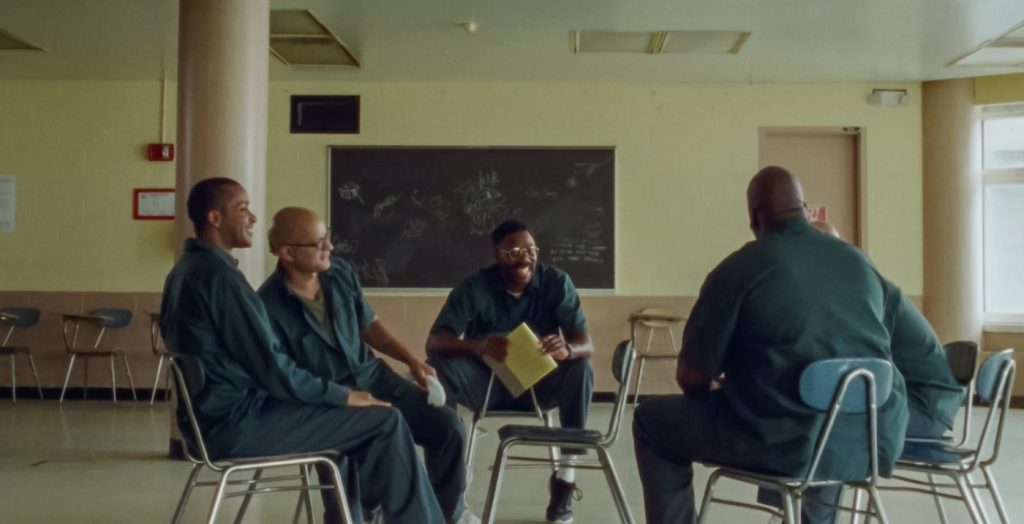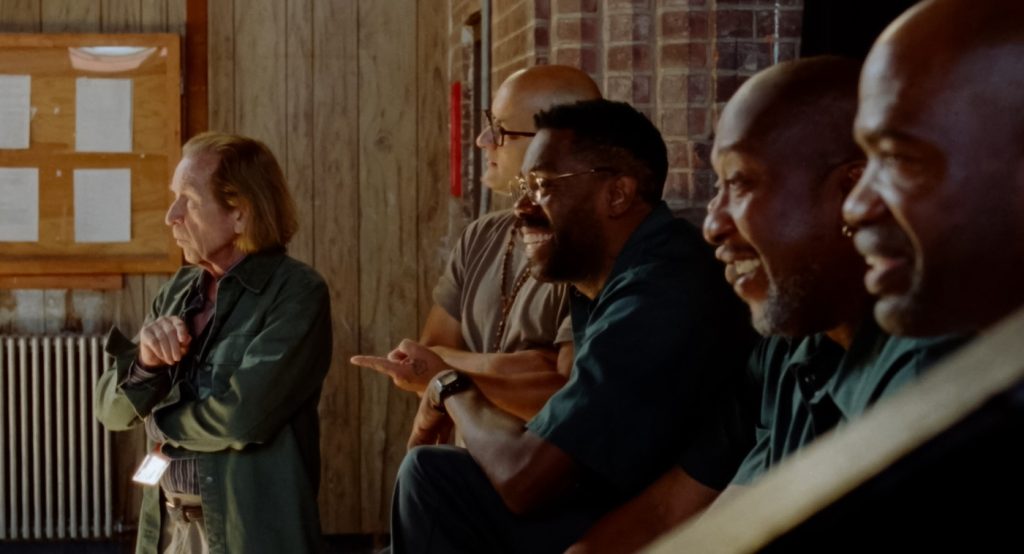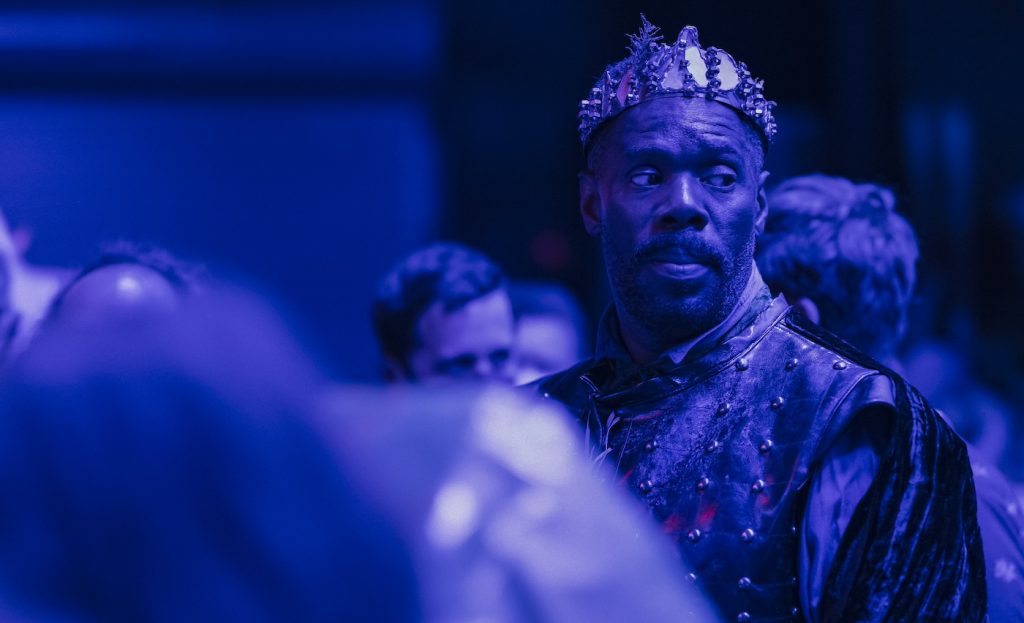“Sing Sing” Cinematographer Pat Scola on Capturing a Raw, Moving Portrait of Humanity
“It was really about getting out of your own way and allowing these men’s story to come to the forefront,” cinematographer Pat Scola tells The Credits about the emotionally stirring film Sing Sing from director Greg Kwedar, which shines a delicate light on the arts rehabilitation program at Sing Sing Correctional Facility. “Greg was the one who led from the front on this, and we were there to help tell the story without putting our hands all over it,” Scola says. “That was a huge goal of ours, and it was a really humbling reminder to just step out of the way. I felt privileged to be there to craft a way to capture it.”
The film stars Colman Domingo (recently nominated for an Oscar for Rustin) as someone who’s been wrongfully convicted of a crime but finds his path in a theater group, acting alongside other men who have been incarcerated. The screenplay is a true story written by Kwedar and Clint Bentley, who capture a powerful story of grace and goodwill that is equally exquisite in its imagery. Scola curated a near documentary feel to the frame that follows the characters, including formerly incarcerated actors, breathing life into their journeys with a cinematic touch of a bygone era.
Part of crafting the visual language was the decision to shoot on Super 16 paired with Super Speed lenses to capture the intimacy of the characters and the spaces. “The experience that we’re trying to tell about these men is about finding their humanity and being humans inside this oppressive place. That was something that we wanted to lift up,” mentions Scola, who also photographed A Quiet Place: Day One the same year.
Below, read how the cinematographer found his purpose in the harrowing, heartfelt story.
This is your first time collaborating with director Greg Kwedar. How did you get involved in the project?
Greg and Clint were doing another film that didn’t end up getting made and they were shopping around looking at some cinematographers. I had just been in that Variety article they do every year, ten cinematographers to watch. I was in it for Pig. I think they saw that, and that’s how they ended up getting in touch with my agent.
How did knowing that this was based on a true story influence your decision making?
When Greg first pitched it to me, I wanted to be part of this story, and I don’t think I had read the script yet. What I got first was this wealth of Zoom videos that Greg was having with the cast, like Clarence [Maclin], Dino [Johnson], and everyone else. And many of those things that came out of those Zooms are generally in the film.

Any examples?
Someone was talking about wearing a watch on the inside. It’s a status symbol which is a big thing in prison in terms of how you assert your level of status. But they said they wore this watch but the time was always wrong. That hit me pretty hard because of how tragic that is. But it kind of launched something for how the film wanted to look a little bit.
How so?
There are very few tells in the film when the movie takes place and over how long. And time functions differently for the men inside in a big way. You’re fighting time. The sort of look that was birthed out of that was that I wanted it to feel a bit out of time. I wanted it to feel like you don’t really know when you’re looking. I was trying to make it feel old. That’s what led us to shoot on Super 16.

What was the shooting schedule for Sing Sing?
It was 19 days in total, but it was only 14 with Colman [Domingo].
How did the short schedule influence the photography?
We were clever about what we could do without Colman. Sometimes, we shot one side of conversations and then returned for them, which is not super ideal, but we did it. And we did it in ways that wouldn’t affect the other actors’ performances. We had to be intentional with everything and understand how it would be edited. There was very little of us just hosing it down with coverage.
What’s so joyous about Sing Sing is how the emotional gravity of the film pulsates through characters and onto the screen. Did you want to express the relationship between Colman and Clarence Maclin any differently visually?
I don’t think the camera treats them differently than any of the other characters. And that’s certainly a conscious choice in the film, in many ways, just in the way it was made. The way we made it as a community and told these guys stories, we wanted everybody to be as front and center and lifted up as possible. And I feel like we never made a lensing choice or something that treated Colman or Clarence differently from anybody else because this is all their stories.
How did you approach lighting the locations?
The film is split between three major locations. There’s Downstate Correctional Facility, Mid-Orange Correctional Facility, and then the Beacon High School in upstate New York. When we scouted Downstate, one of the things that I found the most oppressive about it was the number of windows. Outside those windows are these walls that keep them in, and you’re getting all this daylight, and you can’t touch it. That led us down this path of this being not your normal prison movie. We’re not trying to exploit it and have it gritty, lit with fluorescents, or a dark aesthetic. Instead, it’s warm.
That’s certainly very different from how most films set in prisons are shot.
We allowed the spaces to light themselves and speak to the visual story we were looking to tell. We were very smart and subtractive with our lighting techniques. We didn’t have big lights, and we didn’t have lots of money, so we took away light. But again, it worked for the story we were trying to tell.
How did you want to frame the theater sequences compared to the prison scenes? The former has an airier feeling.
I think a couple of things are happening there that create that feeling. You can see from the first shot where you enter the theater, the very first moment you get to see it in this long roaming one shot that basically shows all of the characters, explores the backstage and ends up on Colman at the end. You get to see everybody in this element. And there’s definitely an aspect that they’re free in this place. And I think we wanted to reflect that a little bit with the camera without being too overt about it, and so, the camera does have this traveling and floating around feeling to it.

Is there something you want audiences to take away from the film?
I would like them to see the wealth of humans that exist behind the walls of these places. The men we worked with are particularly wonderful human beings. I just hope that their perception is open to being changed about what happens to the people who can exist inside prison.
Sing Sing is in select theaters now.
Featured image: Divine G (Colman Domingo), imprisoned at Sing Sing for a crime he didn’t commit, finds purpose by acting in a theatre group alongside other incarcerated men, including wary newcomer (Clarence Maclin). Courtesy A24.



